Abstract
During the terminal stage of skeletal myogenesis, myoblasts stop replicating, fuse to form multinucleate fibers, and express the genes that encode the proteins that convey contractile capacity. Because of this dramatic shift in proliferative state, morphology, and gene expression, it has been possible to readily identify and quantitate terminally differentiating myoblasts. In contrast, it is not clear whether the proliferating cells that give rise to postmitotic myoblasts are equally distinct in their phenotype and in fact whether distinct stages in skeletal myogenesis precede the onset of terminal differentiation. To address these questions, monoclonal antibodies and immunofluorescence microscopy were used to determine that replicating myoblasts from newborn rats do express a muscle-specific phenotype. To identify replicating cells, incorporation of 5-bromo-2'-deoxyuridine (BrdUrd) into DNA was assayed by using anti-BrdUrd antibody. The developmentally regulated, muscle-specific, integral membrane protein H36 and the intermediate-filament protein desmin were scored as markers of the myogenic phenotype. The percentage of BrdUrd+ (i.e., proliferative) cells among H36+ and desmin+ myoblasts was equal to the percentage of BrdUrd+ cells in the entire population, indicating that the expression of H36 and desmin is uniformly characteristic of replicating myoblasts. Inhibition of protein synthesis before and during growth in BrdUrd did not alter the frequency of desmin and H36 immunofluorescence in BrdUrd+ cells. Thus, desmin and H36 were present in the replicating myoblasts prior to the onset of growth in BrdUrd. These results were confirmed using H36+ cells selected by flow cytometry: these purified H36+ myoblasts replicate, express desmin, and differentiate. Similar results were obtained with mouse myoblasts. Desmin expression in these mammalian cells differs from that in chicken embryo myoblasts: only a small proportion of replicating chicken embryo myoblasts express desmin. That replicating mammalian myoblasts have a muscle-specific phenotype serves to define a distinct stage in myogenic development and a specific cell in the myogenic lineage. Further, it implies that there is a regulatory event activated during myogenesis that precedes terminal differentiation and that is required for expression of those genes whose products distinguish the replicating myoblast.
Full text
PDF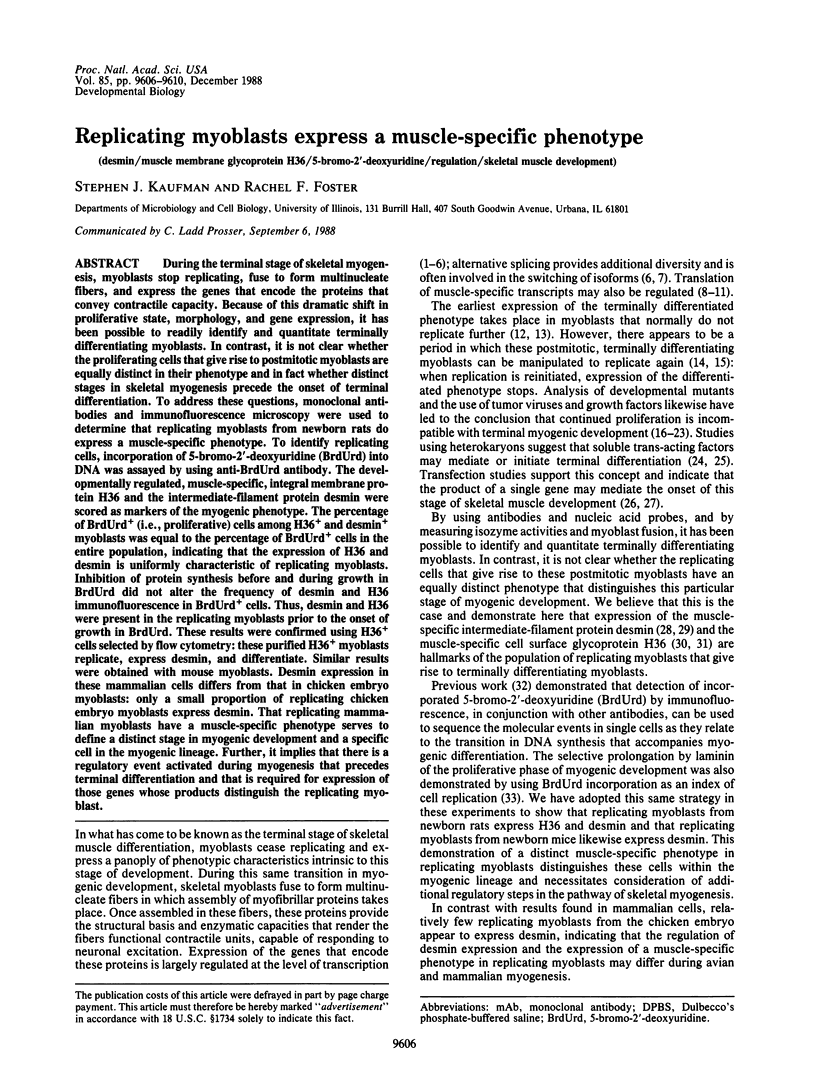
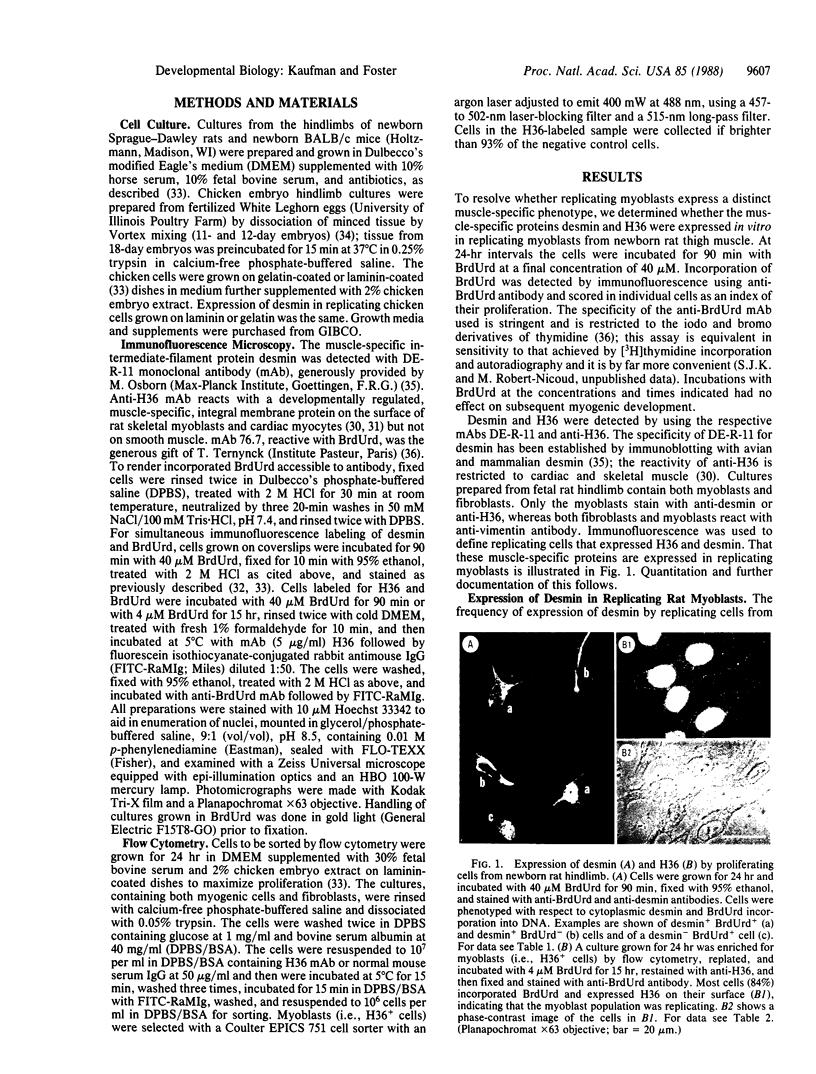
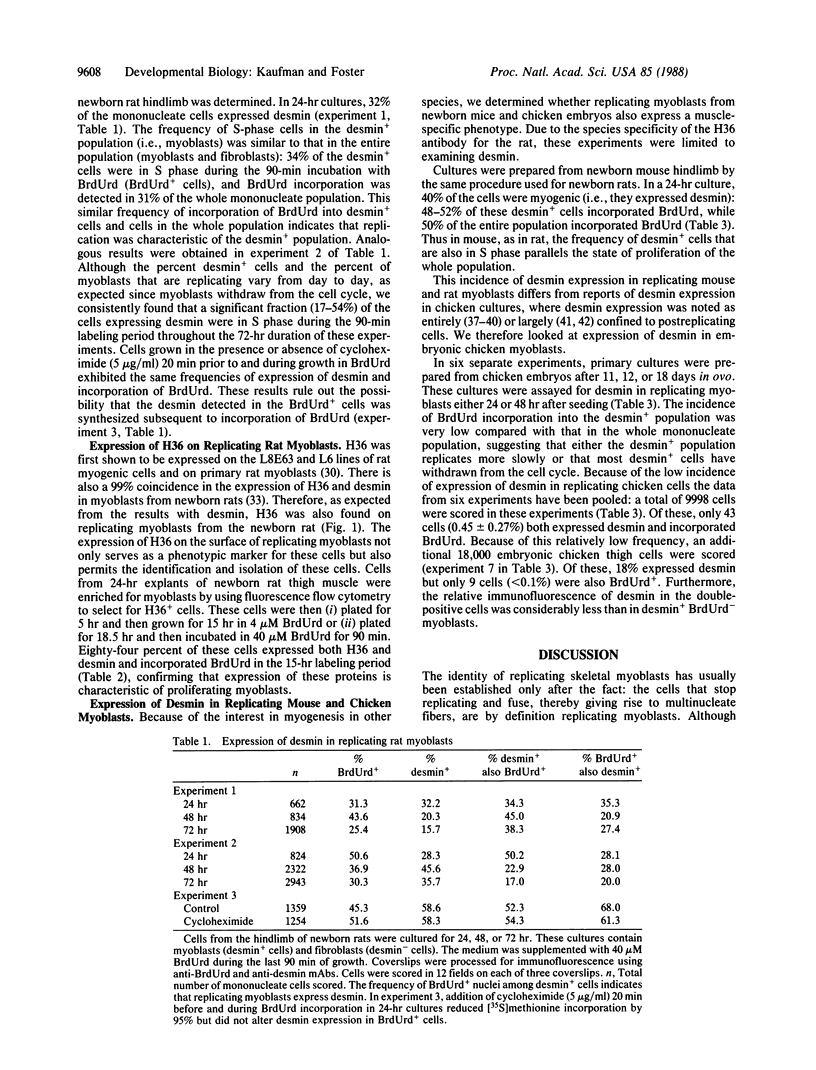
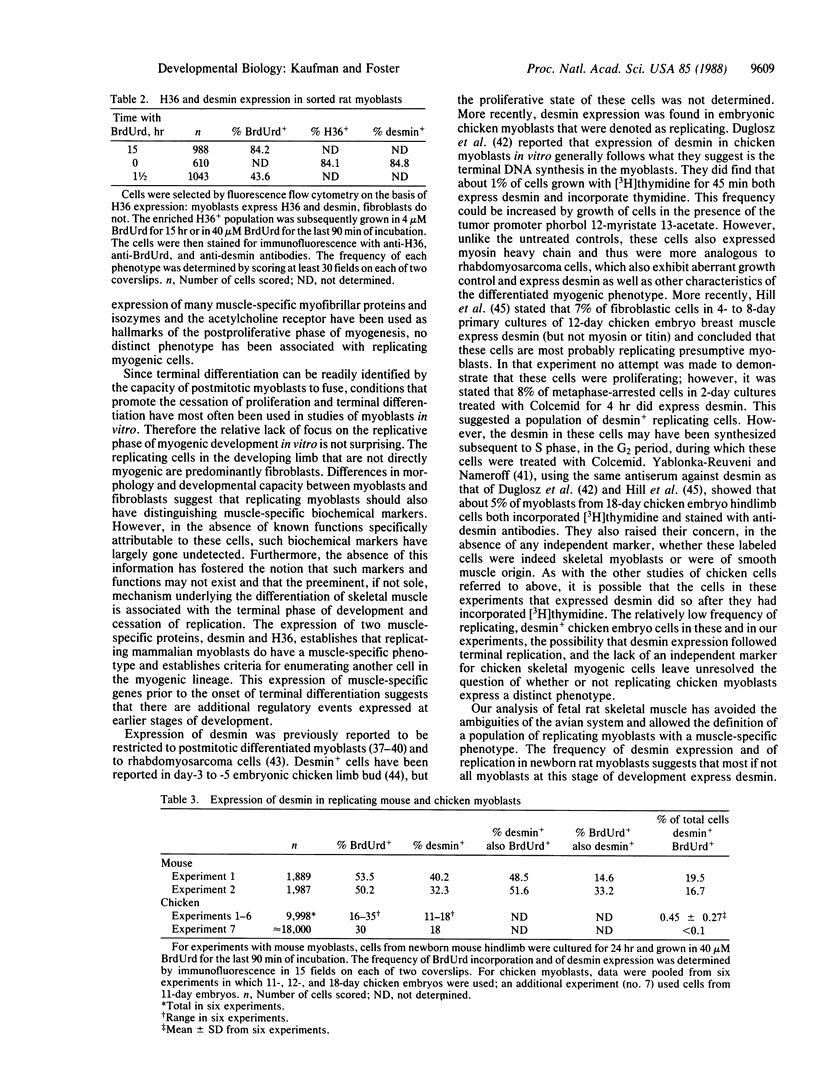
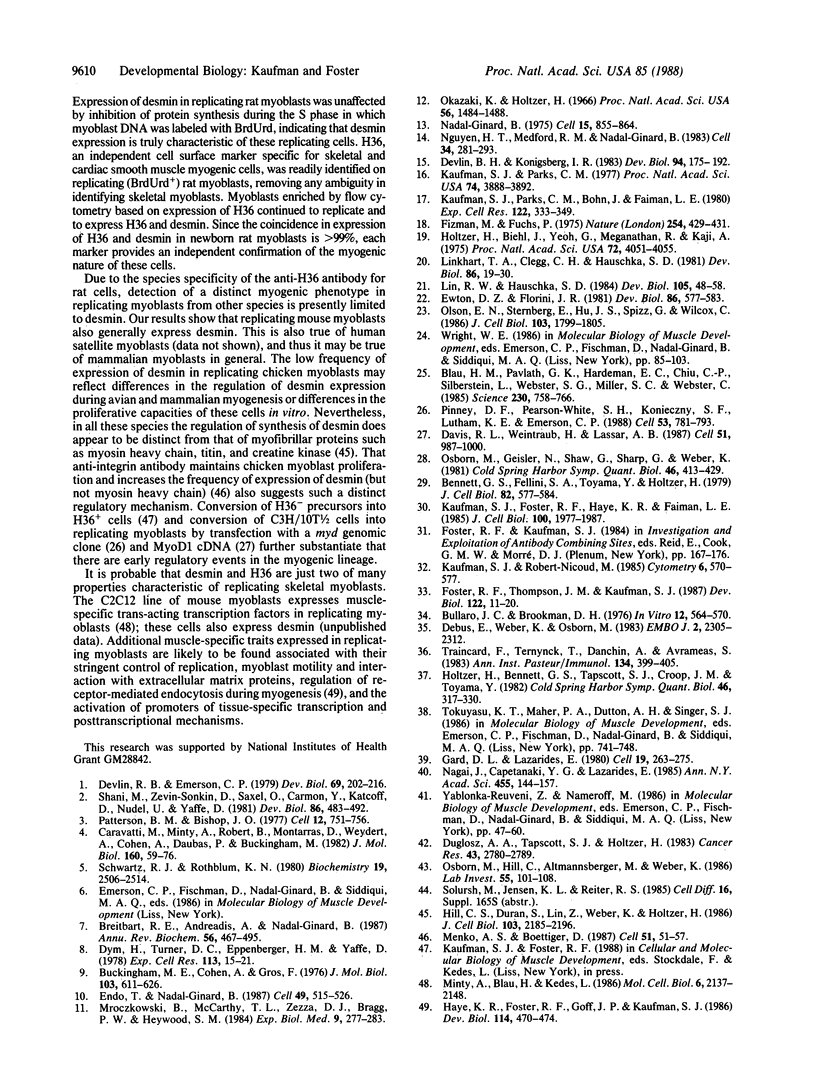
Images in this article
Selected References
These references are in PubMed. This may not be the complete list of references from this article.
- Bennett G. S., Fellini S. A., Toyama Y., Holtzer H. Redistribution of intermediate filament subunits during skeletal myogenesis and maturation in vitro. J Cell Biol. 1979 Aug;82(2):577–584. doi: 10.1083/jcb.82.2.577. [DOI] [PMC free article] [PubMed] [Google Scholar]
- Blau H. M., Pavlath G. K., Hardeman E. C., Chiu C. P., Silberstein L., Webster S. G., Miller S. C., Webster C. Plasticity of the differentiated state. Science. 1985 Nov 15;230(4727):758–766. doi: 10.1126/science.2414846. [DOI] [PubMed] [Google Scholar]
- Breitbart R. E., Andreadis A., Nadal-Ginard B. Alternative splicing: a ubiquitous mechanism for the generation of multiple protein isoforms from single genes. Annu Rev Biochem. 1987;56:467–495. doi: 10.1146/annurev.bi.56.070187.002343. [DOI] [PubMed] [Google Scholar]
- Buckingham M. E., Cohen A., Gros F. Cytoplasmic distribution of pulse-labelled poly(A)-containing RNA, particularly 26 S RNA, during myoblast growth and differentiation. J Mol Biol. 1976 May 25;103(3):611–626. doi: 10.1016/0022-2836(76)90220-5. [DOI] [PubMed] [Google Scholar]
- Bullaro J. C., Brookman D. H. Comparison of skeletal muscle monolayer cultures initiated with cells dissociated by the vortex and trypsin methods. In Vitro. 1976 Aug;12(8):564–570. doi: 10.1007/BF02797440. [DOI] [PubMed] [Google Scholar]
- Caravatti M., Minty A., Robert B., Montarras D., Weydert A., Cohen A., Daubas P., Buckingham M. Regulation of muscle gene expression. The accumulation of messenger RNAs coding for muscle-specific proteins during myogenesis in a mouse cell line. J Mol Biol. 1982 Sep;160(1):59–76. doi: 10.1016/0022-2836(82)90131-0. [DOI] [PubMed] [Google Scholar]
- Davis R. L., Weintraub H., Lassar A. B. Expression of a single transfected cDNA converts fibroblasts to myoblasts. Cell. 1987 Dec 24;51(6):987–1000. doi: 10.1016/0092-8674(87)90585-x. [DOI] [PubMed] [Google Scholar]
- Debus E., Weber K., Osborn M. Monoclonal antibodies to desmin, the muscle-specific intermediate filament protein. EMBO J. 1983;2(12):2305–2312. doi: 10.1002/j.1460-2075.1983.tb01738.x. [DOI] [PMC free article] [PubMed] [Google Scholar]
- Devlin B. H., Konigsberg I. R. Reentry into the cell cycle of differentiated skeletal myocytes. Dev Biol. 1983 Jan;95(1):175–192. doi: 10.1016/0012-1606(83)90016-7. [DOI] [PubMed] [Google Scholar]
- Devlin R. B., Emerson C. P., Jr Coordinate accumulation of contractile protein mRNAs during myoblast differentiation. Dev Biol. 1979 Mar;69(1):202–216. doi: 10.1016/0012-1606(79)90286-0. [DOI] [PubMed] [Google Scholar]
- Dlugosz A. A., Tapscott S. J., Holtzer H. Effects of phorbol 12-myristate 13-acetate on the differentiation program of embryonic chick skeletal myoblasts. Cancer Res. 1983 Jun;43(6):2780–2789. [PubMed] [Google Scholar]
- Dym H., Turner D. C., Eppenberger H. M., Yaffe D. Creatine kinase isoenzyme transition in actinomycin D-treated differentiating muscle cultures. Exp Cell Res. 1978 Apr;113(1):15–21. doi: 10.1016/0014-4827(78)90082-4. [DOI] [PubMed] [Google Scholar]
- Endo T., Nadal-Ginard B. Three types of muscle-specific gene expression in fusion-blocked rat skeletal muscle cells: translational control in EGTA-treated cells. Cell. 1987 May 22;49(4):515–526. doi: 10.1016/0092-8674(87)90454-5. [DOI] [PubMed] [Google Scholar]
- Fiszman M. Y., Fuchs P. Temperature-sensitive expression of differentiation in transformed myoblasts. Nature. 1975 Apr 3;254(5499):429–431. doi: 10.1038/254429a0. [DOI] [PubMed] [Google Scholar]
- Foster R. F., Thompson J. M., Kaufman S. J. A laminin substrate promotes myogenesis in rat skeletal muscle cultures: analysis of replication and development using antidesmin and anti-BrdUrd monoclonal antibodies. Dev Biol. 1987 Jul;122(1):11–20. doi: 10.1016/0012-1606(87)90327-7. [DOI] [PubMed] [Google Scholar]
- Gard D. L., Lazarides E. The synthesis and distribution of desmin and vimentin during myogenesis in vitro. Cell. 1980 Jan;19(1):263–275. doi: 10.1016/0092-8674(80)90408-0. [DOI] [PubMed] [Google Scholar]
- Haye K. R., Foster R. F., Goff J. P., Kaufman S. J. Endocytosis of alpha 2-macroglobulin is developmentally regulated during myogenesis. Dev Biol. 1986 Apr;114(2):470–474. doi: 10.1016/0012-1606(86)90211-3. [DOI] [PubMed] [Google Scholar]
- Hill C. S., Duran S., Lin Z. X., Weber K., Holtzer H. Titin and myosin, but not desmin, are linked during myofibrillogenesis in postmitotic mononucleated myoblasts. J Cell Biol. 1986 Dec;103(6 Pt 1):2185–2196. doi: 10.1083/jcb.103.6.2185. [DOI] [PMC free article] [PubMed] [Google Scholar]
- Holtzer H., Bennett G. S., Tapscott S. J., Croop J. M., Toyama Y. Intermediate-size filaments: changes in synthesis and distribution in cells of the myogenic and neurogenic lineages. Cold Spring Harb Symp Quant Biol. 1982;46(Pt 1):317–329. doi: 10.1101/sqb.1982.046.01.033. [DOI] [PubMed] [Google Scholar]
- Holtzer H., Biehl J., Yeoh G., Meganathan R., Kaji A. Effect of oncogenic virus on muscle differentiation. Proc Natl Acad Sci U S A. 1975 Oct;72(10):4051–4055. doi: 10.1073/pnas.72.10.4051. [DOI] [PMC free article] [PubMed] [Google Scholar]
- Kaufman S. J., Foster R. F., Haye K. R., Faiman L. E. Expression of a developmentally regulated antigen on the surface of skeletal and cardiac muscle cells. J Cell Biol. 1985 Jun;100(6):1977–1987. doi: 10.1083/jcb.100.6.1977. [DOI] [PMC free article] [PubMed] [Google Scholar]
- Kaufman S. J., Parks C. M., Bohn J., Faiman L. E. Transformation is an alternative to normal skeletal muscle development. Exp Cell Res. 1980 Feb;125(2):333–349. doi: 10.1016/0014-4827(80)90128-7. [DOI] [PubMed] [Google Scholar]
- Kaufman S. J., Parks C. M. Loss of growth control and differentiation in the fu-1 variant of the L8 line of rat myoblasts. Proc Natl Acad Sci U S A. 1977 Sep;74(9):3888–3892. doi: 10.1073/pnas.74.9.3888. [DOI] [PMC free article] [PubMed] [Google Scholar]
- Kaufman S. J., Robert-Nicoud M. DNA replication and differentiation in rat myoblasts studied with monoclonal antibodies against 5-bromodeoxyuridine, actin, and alpha 2-macroglobulin. Cytometry. 1985 Nov;6(6):570–577. doi: 10.1002/cyto.990060611. [DOI] [PubMed] [Google Scholar]
- Lim R. W., Hauschka S. D. EGF responsiveness and receptor regulation in normal and differentiation-defective mouse myoblasts. Dev Biol. 1984 Sep;105(1):48–58. doi: 10.1016/0012-1606(84)90260-4. [DOI] [PubMed] [Google Scholar]
- Linkhart T. A., Clegg C. H., Hauschika S. D. Myogenic differentiation in permanent clonal mouse myoblast cell lines: regulation by macromolecular growth factors in the culture medium. Dev Biol. 1981 Aug;86(1):19–30. doi: 10.1016/0012-1606(81)90311-0. [DOI] [PubMed] [Google Scholar]
- Menko A. S., Boettiger D. Occupation of the extracellular matrix receptor, integrin, is a control point for myogenic differentiation. Cell. 1987 Oct 9;51(1):51–57. doi: 10.1016/0092-8674(87)90009-2. [DOI] [PubMed] [Google Scholar]
- Minty A., Blau H., Kedes L. Two-level regulation of cardiac actin gene transcription: muscle-specific modulating factors can accumulate before gene activation. Mol Cell Biol. 1986 Jun;6(6):2137–2148. doi: 10.1128/mcb.6.6.2137. [DOI] [PMC free article] [PubMed] [Google Scholar]
- Nadal-Ginard B. Commitment, fusion and biochemical differentiation of a myogenic cell line in the absence of DNA synthesis. Cell. 1978 Nov;15(3):855–864. doi: 10.1016/0092-8674(78)90270-2. [DOI] [PubMed] [Google Scholar]
- Ngai J., Capetanaki Y. G., Lazarides E. Expression of the genes coding for the intermediate filament proteins vimentin and desmin. Ann N Y Acad Sci. 1985;455:144–157. doi: 10.1111/j.1749-6632.1985.tb50409.x. [DOI] [PubMed] [Google Scholar]
- Nguyen H. T., Medford R. M., Nadal-Ginard B. Reversibility of muscle differentiation in the absence of commitment: analysis of a myogenic cell line temperature-sensitive for commitment. Cell. 1983 Aug;34(1):281–293. doi: 10.1016/0092-8674(83)90159-9. [DOI] [PubMed] [Google Scholar]
- Okazaki K., Holtzer H. Myogenesis: fusion, myosin synthesis, and the mitotic cycle. Proc Natl Acad Sci U S A. 1966 Nov;56(5):1484–1490. doi: 10.1073/pnas.56.5.1484. [DOI] [PMC free article] [PubMed] [Google Scholar]
- Olson E. N., Sternberg E., Hu J. S., Spizz G., Wilcox C. Regulation of myogenic differentiation by type beta transforming growth factor. J Cell Biol. 1986 Nov;103(5):1799–1805. doi: 10.1083/jcb.103.5.1799. [DOI] [PMC free article] [PubMed] [Google Scholar]
- Osborn M., Geisler N., Shaw G., Sharp G., Weber K. Intermediate filaments. Cold Spring Harb Symp Quant Biol. 1982;46(Pt 1):413–429. doi: 10.1101/sqb.1982.046.01.040. [DOI] [PubMed] [Google Scholar]
- Osborn M., Hill C., Altmannsberger M., Weber K. Monoclonal antibodies to titin in conjunction with antibodies to desmin separate rhabdomyosarcomas from other tumor types. Lab Invest. 1986 Jul;55(1):101–108. [PubMed] [Google Scholar]
- Paterson B. M., Bishop J. O. Changes in the mRNA population of chick myoblasts during myogenesis in vitro. Cell. 1977 Nov;12(3):751–765. doi: 10.1016/0092-8674(77)90275-6. [DOI] [PubMed] [Google Scholar]
- Pinney D. F., Pearson-White S. H., Konieczny S. F., Latham K. E., Emerson C. P., Jr Myogenic lineage determination and differentiation: evidence for a regulatory gene pathway. Cell. 1988 Jun 3;53(5):781–793. doi: 10.1016/0092-8674(88)90095-5. [DOI] [PubMed] [Google Scholar]
- Schwartz R. J., Rothblum K. Regulation of muscle differentiation: isolation and purification of chick actin messenger ribonucleic acid and quantitation with complementary deoxyribonucleic acid probes. Biochemistry. 1980 May 27;19(11):2506–2514. doi: 10.1021/bi00552a032. [DOI] [PubMed] [Google Scholar]
- Shani M., Zevin-Sonkin D., Saxel O., Carmon Y., Katcoff D., Nudel U., Yaffe D. The correlation between the synthesis of skeletal muscle actin, myosin heavy chain, and myosin light chain and the accumulation of corresponding mRNA sequences during myogenesis. Dev Biol. 1981 Sep;86(2):483–492. doi: 10.1016/0012-1606(81)90206-2. [DOI] [PubMed] [Google Scholar]
- Traincard F., Ternynck T., Danchin A., Avrameas S. Une technique immunoenzymatique pour la mise en évidence de l'hybridation moléculaire entre acides nucléiques. Ann Immunol (Paris) 1983 Nov-Dec;134D(3):399–404. [PubMed] [Google Scholar]



